A very Happy Birthday to Mr. Charlie Parker! Let’s Celebrate with his version of Perdido!
For this week’s selection, I picked a pair of melodramas that had the word “Heaven” in it.
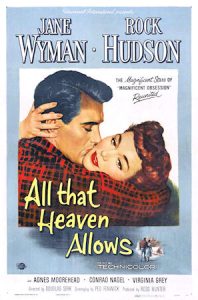 The first film on my list, All THat Heaven Allows, directed by Douglas Sirk starring Jane Wyman and Rock Hudson. Wyman plays Cary Scot, a well to do, but lonely widow living in a generic New England town. Her life consists of two college age children and some friends in her country club including some men who are interested in her but it does not provide any satisfaction.
The first film on my list, All THat Heaven Allows, directed by Douglas Sirk starring Jane Wyman and Rock Hudson. Wyman plays Cary Scot, a well to do, but lonely widow living in a generic New England town. Her life consists of two college age children and some friends in her country club including some men who are interested in her but it does not provide any satisfaction.
In the meantime, she meets Ron Kirby (Hudson) her gardener. A strapping idealist who immediately draws her into his simple life style the two quickly fall in love. But just how long will the opinions of friends and family allow two people or different classes and ages stay together?
This film did an interesting job of looking under the rock of nineteen fifties realism and small town hypocrisy. I was especially drawn in by the Sirk’s use of the bright palette that technicolor provided him. A lot of this doesn’t age very well where a lot of things happening here feel very anachronistic to modern eyes.
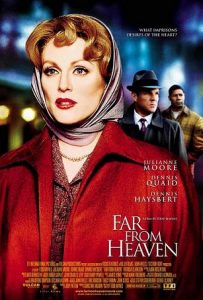 My next film Far From Heaven, directed by Todd Haynes, and starring Julianne Moore, Dennis Quaid and Dennis Haysbert. Moore plays Cathy Whitaker a woman who seems to be the perfect fifties housewife. Her life begins to fall a part when her husband, Frank (Quaid) starts going to gay bars (and gets caught) and takes his frustration out on her. As the strain of her marriage begins to overwhelm her she is drawn to Raymond (Haysbert )a handsome, and black, gardener.
My next film Far From Heaven, directed by Todd Haynes, and starring Julianne Moore, Dennis Quaid and Dennis Haysbert. Moore plays Cathy Whitaker a woman who seems to be the perfect fifties housewife. Her life begins to fall a part when her husband, Frank (Quaid) starts going to gay bars (and gets caught) and takes his frustration out on her. As the strain of her marriage begins to overwhelm her she is drawn to Raymond (Haysbert )a handsome, and black, gardener.
This was a gorgeous film it’s interesting comparing how Haynes is doing his tribute to Sirk here. Sirk creates his palette based on the limitations of technicolor (in a way I found myself reminded of artists like N.C, Wyeth and Howard Pyle who had similar issues compensating for the limits of printing technology at the time. Haynes is mostly imitating Sirk’s style but has access to much better technology, so while is using the same bright color but it has a bit more range and subtly.
While these were both well done I’m afraid I really am not the target audience for this genre. So while I was certainly able to appreciate the craft, watching these was a bit of a chore. But certainly, don’t let my personal taste deter anyone.
I’ve been on a Saul Bass kick for a while, falling love with his incredible opening sequences and stunning posters. One of the posters I liked the best was one from an adaptation of George Bernard Shaw’s Saint Joan by Otto Preminger. Based of this I thought that films about Joan of Arc would be a good theme for the week.
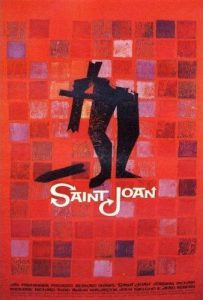 So anyway, as I said, Saint Joan is an adaptation of the Shaw play of the same name, from a screenplay by Graham Greene. I’d read the play years ago. I don’t remember much of it beyond the anachronistic behavior of the characters and the play ending with the dead Joan appearing to King Charles VII in his bedroom.
So anyway, as I said, Saint Joan is an adaptation of the Shaw play of the same name, from a screenplay by Graham Greene. I’d read the play years ago. I don’t remember much of it beyond the anachronistic behavior of the characters and the play ending with the dead Joan appearing to King Charles VII in his bedroom.
In this version the film begins at this point with flashbacks to the beginning of Joan’s career and then moving forward to her trial and execution.
This was pretty good, taking full advantage of Shaw’s witty dialogue and Premiger creating an interesting theatrical quality throughout the film. Any problems I have with it mostly come from Shaw. I’m not completely sure what Shaw was going for here. Many of his plays try to make a satirical point. Here I’m mostly certain he was doing the material straight. Of course from my perspective I’d need a degree on the subject to recognize any of Shaw’s dog whistles.
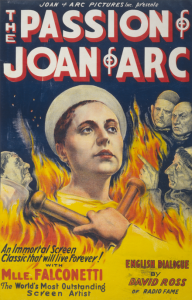 The next film on my list was Carl Theodor Dreyer’s The Passion of Joan of Arc. This is a pretty straight adaptation of a transcript of Joan’s trial as the judges try to trick her into saying things that will discredit her claims. The film is a study of one’s woman’s faith and personal strength and the inevitable tragedy when all of this fails.
The next film on my list was Carl Theodor Dreyer’s The Passion of Joan of Arc. This is a pretty straight adaptation of a transcript of Joan’s trial as the judges try to trick her into saying things that will discredit her claims. The film is a study of one’s woman’s faith and personal strength and the inevitable tragedy when all of this fails.
This really isn’t really a film for every one. It has an extremely expressionistic style and consists almost entirely of closeups. I mostly enjoyed it as a study of some wonderful faces and expressions.
I while watching one of my favorite film theory youtube channels the other day when It spent a minute talking about British New Wave. Since I’d never even heard of British New Wave (at least not under that name) I thought this would make for a good theme to base this week’s selection on.
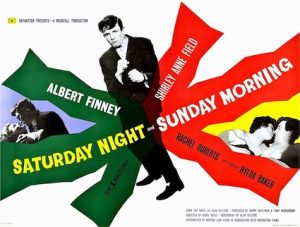 The first film on my selection, Karel Reisz’s Saturday Night and Sunday Morning, based on the novel of the same name by Alan Sillitoe, tells the story Arthur Seaton, a machinist working in a bicycle factory in Nottingham, played by Albert Finney. Arthur is jaded by all of the people around him who he thinks have either wasted their lives, or have been burnt out, and refuses to be like them.
The first film on my selection, Karel Reisz’s Saturday Night and Sunday Morning, based on the novel of the same name by Alan Sillitoe, tells the story Arthur Seaton, a machinist working in a bicycle factory in Nottingham, played by Albert Finney. Arthur is jaded by all of the people around him who he thinks have either wasted their lives, or have been burnt out, and refuses to be like them.
He goes about this by going to a lot of pubs to drink on Saturday nights and having an affair with a coworker’s wife.
This was an interesting film. The strong Midlands accents made it a little hard to follow, but it does a good job of showing lower-class life in 1960 Britain and doesn’t shirk from controversial issues, like abortion.
What makes this film work though is the fantastic performance from Finny playing Arthur as an arrogant bastard and a compulsive liar.
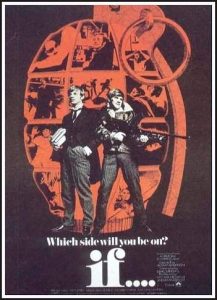 The next on my list, Lindsay Anderson‘s if… starts out with what looks like a brutal expose on British public schools but then it seems to change its mind half way through and gets REALLY weird.
The next on my list, Lindsay Anderson‘s if… starts out with what looks like a brutal expose on British public schools but then it seems to change its mind half way through and gets REALLY weird.
It’s a new term at College house and all the students are from new students terrified about what’s going to happen to them to the jaded veterans like Mick Travis played by Malcolm McDowell starting out his film Career. From here we watch day to day life at the school, with its petty rivalries, bullying, and classist pecking order. Until the whole thing explodes… almost literally.
This was a fun film. McDowell’s performance as a high school rebel gives us a taste of what he would do as Alex in Kubrick’s Clockwork Orange. It goes back and forth from humor to horror to flat out surrealism. Part of me kept comparing it to Harry Potter… Though if Hogwarts was anything like College House, Voldemort would have run away in terror.
https://www.youtube.com/watch?v=Z9JL8Dae_yQ
A very special birthday for Mr. Louis Armstrong with We Have All The Time in the World
For this week’s selection, I did films that were explicitly lit about Sherlock Holmes. Or to be more precise, films about reasonable facsimiles of Sherlock Holmes but really aren’t fooling anybody.
On a nice side note these were pretty obscure titles and definitely put the breadth of Scarecrow’s collection to the test.
Kudos.
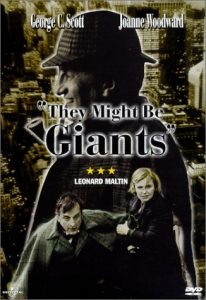 The first film on my list was They Might Be Giants starring George C Scott. (In case anyone is wondering this is the film that the band got their name from) Scott plays Justin Playfair, a former lawyer, who, since his wife died, has become convinced he is Sherlock Holmes. His Brother tries to get him committed, (partially for his own good and partially to get control of his fortune) He is taken into the hands of Dr. Mildred Watson (Joanne Woodward) and now that Holmes has his Watson he can now solve his greatest mystery… Whatever it is.
The first film on my list was They Might Be Giants starring George C Scott. (In case anyone is wondering this is the film that the band got their name from) Scott plays Justin Playfair, a former lawyer, who, since his wife died, has become convinced he is Sherlock Holmes. His Brother tries to get him committed, (partially for his own good and partially to get control of his fortune) He is taken into the hands of Dr. Mildred Watson (Joanne Woodward) and now that Holmes has his Watson he can now solve his greatest mystery… Whatever it is.
This was a fun little film based loosely on one of the main premises of Don Quixote. “Sure, we know they’re windmills… but they MIGHT be giants”. Following a series of strange clues (such as bags of garbage) Justin leads Mildred down the rabbit hole to a different perspective where disenfranchised mad people live in their own world and are quite happy about it, thank you very much.
I enjoyed this film. Sure it was short and mushy, it was a lot of fun. To put this in very geeky gamer terms I kept imagining this to be a story about a VERY benign coterie of Malkavians from the World of Darkness… and Scott and Woodward play off each other very well.
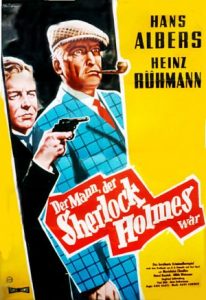 My next film is the German 1933 film, The Man Who Was Sherlock Holmes. Tells the story of two con artists (or at least we think they’re con artists) Morris Flynn (Hans Albers) and Macky McMacpherson (Heinz Rühmann) who try to pass themselves off as Holmes and Watson (in their defense they don’t SAY they’re Holmes and Watson… they just get on the train dressed in a deerstalker smoking a pipe and carrying a violin when they give their real names… they just don’t correct anyone who assumes they’re Holmes and Watson in disguise.
My next film is the German 1933 film, The Man Who Was Sherlock Holmes. Tells the story of two con artists (or at least we think they’re con artists) Morris Flynn (Hans Albers) and Macky McMacpherson (Heinz Rühmann) who try to pass themselves off as Holmes and Watson (in their defense they don’t SAY they’re Holmes and Watson… they just get on the train dressed in a deerstalker smoking a pipe and carrying a violin when they give their real names… they just don’t correct anyone who assumes they’re Holmes and Watson in disguise.
This gets them free passage on the hotel and free room and board at a fancy hotel. But it also gets them the attention of the police who want their help with a counterfeiting ring.
I’m not sure if I can truly recommend this film, but it was fairly well done, with solid comic performances from the leads, and perfectly enjoyable.
Regarding where and when it was made, the cynic in me kept regarding it as a propaganda film, as if it was trying to tell me “See? All of us Germans are happy people! Nothing to see here!”
https://www.youtube.com/watch?v=Rqzl5fY3_Kw






